|
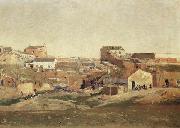 |
Aureliano De Beruete Y Moret
|
|
Spanish , Madrid, 1845 - Madrid, 1912
Spanish writer, painter and collector. After pursuing a political career and taking a doctorate in civil and canon law, he dedicated himself to writing on art and produced important studies on Diego Velezquez (1898), Joaqu'n Sorolla y Bastida (1901) and other artists. He travelled extensively and enthusiastically in Europe (France, Belgium, Switzerland, the Netherlands, Italy, Germany, England and elsewhere), studying especially the different national schools of painting. On his travels he also painted landscapes. After working for some time as a copyist in the Museo del Prado, Beruete decided in 1873 to concentrate his efforts on painting and on learning to perfect his craft. He enrolled at the Escuela Superior de Bellas Artes de S Fernando in Madrid and also studied at the studio of Carlos de Haes. Beruete was among the founders of the Instituci'n Libre de Enseeanza, and with its members, and with Carlos de Haes, he made several study trips abroad. In Paris he came to know the painting of the Barbizon school, and in Belgium he assimilated the teaching of the generation of landscape artists who had adopted a form of Realism. |
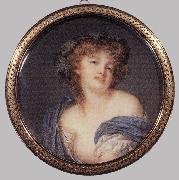 |
AUGUSTIN, Jacques-Jean-Baptiste
|
|
French miniaturist (b. 1759, Saint-Di? d. 1832, Paris)
1832). French painter. After receiving instruction in art from Jean Girardet (1709-78) and Jean-Baptiste-Charles Claudot (1733-1805), he went to Paris in 1781, where he won recognition as a miniature painter. The miniatures he painted in the 1790s, for example his portrait of Mme Vanh?e, n?e Dewinck (1792; Paris, Louvre), are among his most animated works; often portraying figures in a landscape setting, they develop the exuberant style of Niclas Lafrensen and Peter Adolf Hall. He also admired the work of Jean-Baptiste Greuze, whose Bacchante (Waddesdon Manor, Bucks, NT) in his own collection he copied in miniature (London, Wallace) and in enamel (Paris, Louvre). |
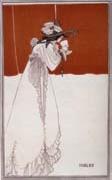 |
Aubrey Beardsley
|
|
English Art Nouveau/Golden Age Illustrator, 1872-1898
English draughtsman and writer. He was brought up in Brighton, in genteel poverty, by his mother. She gave her children an intensive education in music and books, and by the time he was sent to boarding-school at the age of seven Beardsley was exceptionally literate and something of a musical prodigy. He was also already infected with the tuberculosis that eventually killed him. There is evidence that his talent for drawing was highly developed by the age of ten, and he was subsequently encouraged by his housemaster at Brighton Grammar School, Arthur William King. Beardsley left school at the end of 1888, and in January 1889 became a clerk at the Guardian Life and Fire Insurance Company in the City of London. Attacks of haemorrhaging of the lungs forced him to abandon his job at the end of 1889. On the strength of a short story sold to Tit Bits he tried to pursue a literary career, but when his health improved in the spring of 1890, he returned both to his job and to drawing. Final affirmation of the direction of his art came in July 1891, when he showed his work to Edward Burne-Jones, who told Beardsley: 'I seldom or never advise anyone to take up art as a profession, but in your case I can do nothing else. |
 |
AST, Balthasar van der
|
|
Dutch Baroque Era Painter, ca.1593-1656
1657). Dutch painter. He was the brother-in-law of Ambrosius Bosschaert (i), whose household he entered in 1609, after the death of his father. He remained as Bosschaert's pupil, until he was 21. In 1615 van der Ast moved with the Bosschaert family to Bergen-op-Zoom. However, a year later the Bosschaerts were living in Utrecht, but van der Ast is not recorded there until 1619, when he was entered as a master in the Guild of St Luke. He remained in Utrecht until 1632, then lived in Delft, where he enrolled in the painters' guild on 22 June 1632. On 26 February 1633 he married Margrieta Jans van Bueren in Delft, where he spent the rest of his career; the marriage produced two children. |
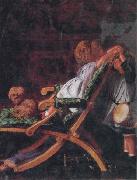 |
Arthur Boyd Houghton
|
|
English Painter and Illustrator , 1836-1875
His work was varied and was revered during the mid-19th century. He traveled to America and Russia, creating illustrations for The Graphic and for numerous books, including The Arabian Nights and Don Quixote. His work was strongly influenced by the Pre-Raphaelite Brotherhood. Paul Hogath wrote a biography, published in 1981 by Gordon Fraser Work by this artist is held within various public collections incluiding Tate Britain in London, as well as a number of private collections around the world. Houghton is best known for etchings but also produced a number of oil paintings, many of his wife and children. He also wrote a little poetry which was published in his lifetime. |
 |
Arthur Bowen Davies
|
|
1862-1928
Arthur Bowen Davies Gallery
Arthur Bowen Davies (September 26, 1863 ?C October 24, 1928) was an avant-garde American artist.
He was born in Utica, New York and studied at the Chicago Academy of Design from 1879 to 1882. He briefly attended the Art Institute of Chicago and then moved to New York City where he studied at the Art Students League.
Davies was a principal organizer of the 1913 Armory Show and was a member of The Eight, a group of painters including five associated with the Ashcan school: William Glackens (1870-1938), Robert Henri (1865-1929), George Luks (1867-1933), Everett Shinn (1876-1953) and John French Sloan (1871-1951), along with Arthur B. Davies (1862-1928), Ernest Lawson (1873-1939) and Maurice Prendergast (1859-1924). Davies is best known for his ethereal figure paintings. He worked as a billboard painter, engineering draftsman, and magazine illustrator. |
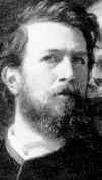 |
Arnold Bocklin
|
|
Swiss
1827-1901
Arnold Bocklin Locations
Arnold Bocklin was born on Oct. 16, 1827, in Basel. He attended the Dusseldorf Academy (1845-1847). At this time he painted scenes of the Swiss Alps, using light effects and dramatic views subjectively to project emotional moods into the landscape. In 1848 this romantic introspection gave way to plein air (open-air) objectivity after he was influenced by Camille Corot, Eugene Delacroix, and the painters of the Barbizon school while on a trip to Paris. But after the February and June revolutions Bocklin returned to Basel with a lasting hatred and disgust for contemporary France, and he resumed painting gloomy mountain scenes.
In 1850 Bocklin found his mecca in Rome, and immediately his paintings were flooded by the warm Italian sunlight. He populated the lush southern vegetation, the bright light of the Roman Campagna, and the ancient ruins with lonely shepherds, cavorting nymphs, and lusty centaurs. These mythological figures rather than the landscapes became Bocklins primary concern, and he used such themes as Pan Pursuing Syrinx (1857) to express the polarities of life: warm sunshine contrasts with cool, moist shade, and the brightness of womans spirituality contrasts with mans dark sensuality.
When Bocklin returned to Basel with his Italian wife, he completed the painting which brought him fame when the king of Bavaria purchased it in 1858: Pan among the Reeds, a depiction of the Greek phallic god with whom the artist identified. He taught at the Academy of Art in Weimar from 1860 to 1862, when he returned to Rome. Called to Basel in 1866, he painted the frescoes and modeled the grotesque masks for the facade of the Basel Museum.
Bocklin resided in Florence from 1874 until 1885, and this was his most active period. He continued to explore the male-female antithesis and painted religious scenes, allegories of Natures powers, and moody studies of mans fate. He ceased working with oils and began experimenting with tempera and other media to obtain a pictorial surface free of brushstrokes.
Bocklin spent the next 7 years mostly in Switzerland, with occasional trips to Italy; he devoted much of his energy to designing an airplane. Following a stroke in 1892, he returned to Italy, bought a villa in Fiesole, and died there on Jan. 16, 1901. Many of his late works depict nightmares of war, plague, and death. |
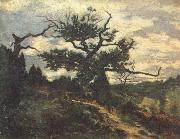 |
Antoine louis barye
|
|
French Romantic Sculptor and Painter, ca.1795-1875, He was a French sculptor most famous for his work as an animalier. Born in Paris, Barye began his career as a goldsmith, like many sculptors of the Romantic Period. After studying under sculptor Francois-Joseph Bosio and painter Baron Antoine-Jean Gros he was in 1818 admitted to the Ecole des Beaux Arts. But it was not until 1823, while working for Fauconnier, the goldsmith, that he discovered his true predilection from watching the wild beasts in the Jardin des Plantes, making vigorous studies of them in pencil drawings comparable to those of Delacroix, then modelling them in sculpture on a large or small scale. In 1831 he exhibited his "Tiger devouring a Crocodile", and in 1832 had mastered a style of his own in the "Lion and Snake." Thenceforward Barye, though engaged in a perpetual struggle with want, exhibited year after year these studies of animals--admirable groups which reveal him as inspired by a spirit of true romance and a feeling for the beauty of the antique, as in "Theseus and the Minotaur" (1847), "Lapitha and Centaur" (1848), |
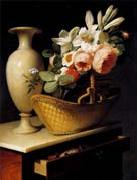 |
Antoine Berjon
|
|
French Romantic Painter, 1754-1843,French painter, teacher and designer. According to his uncorroborated 19th-century biographer J. Gaubin, he was intended for holy orders and began studying flower painting as a novice (Rev. Lyon., i, 1856). Certainly he studied drawing under the sculptor Antoine-Michel Perrache (1726-79) and worked for Lyon's silk industry as a textile designer, visiting Paris annually, ostensibly to keep abreast of the latest fashions. He first exhibited at the Paris Salon of 1791 and settled in Paris in about 1794, probably as a consequence of the catastrophic siege and destruction of Lyon by revolutionary forces the previous year. Initially he eked out a precarious living decorating snuff-boxes and painting miniatures, supported by friends such as Marceline Desbordes-Valmore, the poetess, and the miniature painter Jean-Baptiste Augustin, to whom Berjon dedicated The Gift (1797; Lyon, Mus. B.-A.). He contributed to seven Paris Salons between 1796 and 1819 and again in 1842, and he had built up a considerable reputation for his work by the early 19th century. |
 |
anna brondum
|
|
Omkring 1900 drog en rad av kvinnliga konstnärer från Norden mot Frankrike, Italien, Tyskland och andra länder i Europa. Hanna Pauli, Sigrid Hjerten och Anna Bröndum är i dag kända, men den vårgårdafödda Hilda Heyman hörde också till dessa målande kvinnor. Hon är inte så känd men väl erkänd i konstnärliga kretsar och representerad på många konstmuseer. |
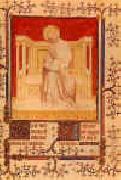 |
Andre Beauneveu
|
|
Netherlandish Gothic Era Painter and Sculptor, 1335-ca.1401
Andre Beauneveu was born in Valenciennes. Little is known about his early life and he is first documented in 1360. Four years later, he commissioned to create a collection of royal tombs in Paris for King Charles V. In 1366, Beauneveau left Paris and began working for the Count of Flanders in Courtrai beginning in 1374. Then in 1386, he began working for Jean, Duc de Berry and served him for the rest of his life. Beauneveau was primarily a sculptor, but also produced illuminated manuscripts and stained glass windows. His work was integral to the development of naturalism in the 15th century. |
 |
AMMANATI, Bartolomeo
|
|
Italian Mannerist Sculptor, 1511-1592
Italian sculptor and architect. He was a major figure in Italian art in the second and third quarters of the 16th century. His extensive travels in north and central Italy gave him an unequalled understanding of developments in architecture and sculpture in the era of Mannerism. His style was based inevitably on the example of Michelangelo but was modified by the suaver work of Jacopo Sansovino. In both sculpture and architecture Ammanati was a highly competent craftsman, and his masterpieces, the tombs of Marco Mantova Benavides and two members of the del Monte family, the Fountains of Juno and Neptune and the courtyard of the Palazzo Pitti, are among the finest works of the period. |
 |
Ambrosius Bosschaert
|
|
(Antwerp, January 18, 1573?CThe Hague, 1621) was a still life painter of the Dutch Golden Age.He started his career in Antwerp, but spend most of it in Middelburg (1593?C1613), where he became dean of the painters' guild. He later worked in Amsterdam (1614), Bergen op Zoom (1615?C1616), Utrecht (1616?C1619), and Breda (1619). He specialised in painting still lifes with flowers. In 1587, Ambrosius Bosschaert moved from Antwerp to Middelburg with his family because of the threat of religious persecution. At the age of twenty-one, he joined the cityes Guild of Saint Luke. Not long after, Bosschaert had established himself as a leading figure in the fashionable floral painting genre.
|
 |
Alfred Thompson Bricher
|
|
1837-1908
Alfred Thompson Bricher (born in Portsmouth, New Hampshire on April 10, 1837; died in Staten Island, New York on September 30, 1908) was a painter associated with White Mountain art and the Hudson River School.
He began as a businessman in Boston, Massachusetts before becoming a professional painter. He studied at the Lowell Institute when not working. He also studied with Albert Bierstadt, William Morris Hunt, and others In 1868 he moved to New York City and in the 1870s primarily did maritime themed paintings.
|
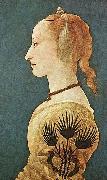 |
Alesso Baldovinetti
|
|
(October 14, 1427??August 29, 1499) was an Italian early Renaissance painter.
Baldovinetti was born in Florence to a family of a rich merchant. In 1448 he was registered as a member of the Guild of St. Luke: "Alesso di Baldovinetti, dipintore."
He was a follower of the group of scientific realists and naturalists in art which included Andrea del Castagno, Paolo Uccello and Domenico Veneziano. Tradition says that he assisted in the decorations of the church of S. Egidio, however no records confirm this. These decoration were carried out during the years 1441 - 1451 by Domenico Veneziano and in conjunction with Andrea del Castagno. That he was commissioned to complete the series at a later date (1460) is certain.
In 1462 Alesso was employed to paint the great fresco of the Annunciation in the cloister of the Annunziata basilica. The remains as we see them give evidence of the artist's power both of imitating natural detail with minute fidelity and of spacing his figures in a landscape with a large sense of air and distance; and they amply verify two separate statements of Vasari concerning him: that "he delighted in drawing landscapes from nature exactly as they are, whence we see in his paintings rivers; bridges, rocks, plants, fruits, roads, fields, cities, exercise grounds, and an infinity of other such things," and that he was an inveterate experimentalist in technical matters.
His favourite method in wall-painting was to lay in his compositions in fresco and finish them a secco with a mixture of yolk of egg and liquid varnish. This, says Vasari, was with the view of protecting the painting from damp; but in course of time the parts executed with this vehicle scaled away, so that the great secret he hoped to have discovered turned out a failure. In 1463 he furnished a cartoon of the Nativity, which was executed in tarsia by Giuliano de Maiano in the sacristy of the cathedral and still exists. From 1466 date the groups of four Evangelists and four Fathers of the Church in fresco, together with the Annunciation on an oblong panel, which still decorate the Portuguese chapel in the basilica of San Miniato, and are given in error by Vasari to Piero Pollaiuolo. A fresco of the risen Christ between angels inside a Holy Sepulchre in the chapel of the Rucellai family, also still existing, belongs to 1467.
In 1471 Alesso undertook important works for tile church of Santa Tr??nita on the commission of Bongianni Gianfigliazzi. First, to paint an altar-piece of the Virgin and Child with six saints; this was finished in 1472: next, a series of frescoes from the Old Testament which was to be completed according to contract within five years, but actually remained on hand for fully sixteen. In 1497 the finished series, which contained many portraits of leading Florentine citizens, was valued at a thousand gold forms by a committee consisting of Cosimo Rosselli, Benozzo Gozzoli, Perugino and Filippino Lippi; only some defaced fragments of it now remain. |
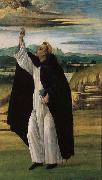 |
Alessandro Botticelli
|
|
Florence ca.1445-1510
Italian painter and draughtsman. In his lifetime he was one of the most esteemed painters in Italy, enjoying the patronage of the leading families of Florence, in particular the Medici and their banking clients. He was summoned to take part in the decoration of the Sistine Chapel in Rome, was highly commended by diplomatic agents to Ludovico Sforza in Milan and Isabella d'Este in Mantua and also received enthusiastic praise from the famous mathematician Luca Pacioli and the humanist poet Ugolino Verino. By the time of his death, however, Botticelli's reputation was already waning. He was overshadowed first by the advent of what Vasari called the maniera devota, a new style by Perugino, Francesco Francia and the young Raphael, whose new and humanly affective sentiment, infused atmospheric effects and sweet colourism took Italy by storm; |
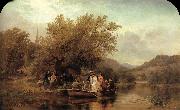 |
Albert Fitch Bellows
|
|
Nov.29.1829-Nov.24.1883, American landscape painter of the Hudson River School, was born at Milford, Massachusetts. He first studied architecture and opened his own architectural firm in 1849, but quickly turned to painting. From 1850 to 1856 he taught at the New England School of Design in Boston. He resigned his post to travel and study abroad, and spent time in Paris and at the Royal Academy at Antwerp as well as in England. He exhibited his first work at the National Academy of Design in 1857, becoming a full member in 1861, and he settled in New York City in 1858 on his return to America. Bellows spent most of his remaining career in New York, though he briefly moved to Boston. He visited Europe again in 1867. In New York he kept a studio in the same building as many of the notable Hudson River School artists of the time. His landscape work of the 1860s is fully in the late Hudson River School tradition, though Bellows depicted people more prominently in his landscapes than most other artists. He excelled at figurative scenes. Bellows also differed from most Hudson River School artists in that he became skilled at watercolor, and authored a respected book on the subject titled "Water-Color Painting: Some Facts and Authorities in Relation to Its Durability". He eventually maintained two studios, one for oil paintings and one for watercolor. He was a member of the American Watercolor Society, and an honorary member of the Royal Belgian Society of Water-Colorists. Bellows also mastered etching??along with Samuel Colman he was possibly the only other Hudson River School artist to do so??and became a member of the New York Etching Club, the Philadelphia Society of Etchers and the Royal Society of Painter-Etchers and Engravers in London, England, an esteemed professional organization whose members included James McNeil Whistler and Francis Seymour Haden. He died in Auburndale, |
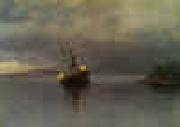 |
Albert Bierstadt
|
|
German-born American Hudson River School Painter, 1830-1902
Bierstadt was born in Solingen, Germany. His family moved to New Bedford, Massachusetts, in 1833. He studied painting with the members of the D??sseldorf School in D??sseldorf, Germany from 1853 to 1857. He taught drawing and painting briefly before devoting himself to painting.
Bierstadt began making paintings in New England and upstate New York. In 1859, he traveled westward in the company of a Land Surveyor for the U.S. government, returning with sketches that would result in numerous finished paintings. In 1863 he returned west again, in the company of the author Fitz Hugh Ludlow, whose wife he would later marry. He continued to visit the American West throughout his career.
Though his paintings sold for princely sums, Bierstadt was not held in particularly high esteem by critics of his day. His use of uncommonly large canvases was thought to be an egotistical indulgence, as his paintings would invariably dwarf those of his contemporaries when they were displayed together. The romanticism evident in his choices of subject and in his use of light was felt to be excessive by contemporary critics. His paintings emphasized atmospheric elements like fog, clouds and mist to accentuate and complement the feel of his work. Bierstadt sometimes changed details of the landscape to inspire awe. The colors he used are also not always true. He painted what he believed is the way things should be: water is ultramarine, vegetation is lush and green, etc. The shift from foreground to background was very dramatic and there was almost no middle distance
Nonetheless, his paintings remain popular. He was a prolific artist, having completed over 500 (possibly as many as 4000) paintings during his lifetime, most of which have survived. Many are scattered through museums around the United States. Prints are available commercially for many. Original paintings themselves do occasionally come up for sale, at ever increasing prices. |
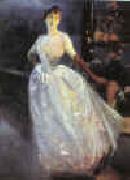 |
Albert Besnard
|
|
1849-1934
French
Albert Besnard Art Locations
(b Paris, 2 June 1849; d Paris, 4 Dec 1936). French painter, printmaker and designer. He was born to an artistic family and was precociously talented. In 1866 he entered the Ecole des Beaux-Arts, where he studied under Jean Franois Brmond (1807-68) and Alexandre Cabanel. His Salon dbut in 1868 and his subsequent entries were well received, and in 1874 he won the Prix de Rome with the Death of Timophanes, Tyrant of Corinth (Paris, Ecole N. Sup. B.-A.). Remaining in Italy for five years, Besnard worked in an academic style influenced by Pietro da Cortona and Michelangelo. |
 |
Albert Baertsoen
|
|
Belgian, 1866-1922.Belgian painter and etcher. The son of a successful mill-owner and an excellent musician, he was a pupil and friend of Gustave Den Duyts (1850-97), and later, at the Ghent Acad?mie, of Jean Delvin (1853-1922). He was involved in the exhibiting society LEssor in Brussels as well as the triennial salons held in Brussels, Antwerp and Ghent in rotation. Among his earliest important works are The Scheldt at Dendermonde (1887; Ghent, Mus. S. Kst.), which he painted beside Isidore Meyers (1836-1917) and Franz Courtens in a Realist style characteristic of the Dendermonde school. In 1889-90 he attended the studio of Alfred Roll in Paris, where he met Jacques-Emile Blanche and Charles Cottet, and became particularly closely associated with Frits Thaulow, Emile-Ren? M?nard and Edmond Aman-Jean. He exhibited regularly at the Salon in Paris. Although Baertsoen is considered to be one of the first Belgian Impressionists, he belonged to no particular school. He was more than a descriptive landscape painter, for he sought to evoke through the depiction of the natural world a mood of melancholy and resignation. He painted silent streets, rocks, rivers and canals in Bruges, Li?ge, Nieuwpoort, Diksmuide and in London, where he stayed during World War I. His most important paintings, however, were inspired by his native town, Ghent, of which he built up a remarkable portrait over the years in such works as Barges in the Snow (1901) and Ghent in the Evening (1903; both Brussels, Mus. A. Mod.). A broad, spontaneous technique, great delicacy of nuance, deep sincerity as well as a certain meditative quality characterize his work, which is limited in quantity. Baertsoen played an important role in Belgian cultural life of his period and was elected to the Acad?mie Royale des Beaux-Arts in 1919. |
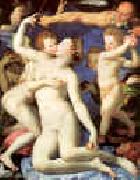 |
Agnolo Bronzino
|
|
Italian Mannerist Painter, 1503-1572
Agnolo di Cosimo (November 17, 1503 ?C November 23,1572), usually known as Il Bronzino, or Agnolo Bronzino (mistaken attempts also have been made in the past to assert his name was Agnolo Tori and even Angelo (Agnolo) Allori), was an Italian Mannerist painter from Florence. The origin of his nickname, Bronzino is unknown, but could derive from his dark complexion, or from that he gave many of his portrait subjects. It has been claimed by some that he had dark skin as a symptom of Addison disease, a condition which affects the adrenal glands and often causes excessive pigmentation of the skin. |
 |
adriaen backer
|
|
the anatomy lesson of dr frederick ruysch,
1670. amsterdams historisch museum |
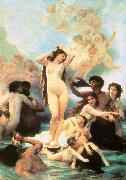 |
Adolphe William Bouguereau
|
|
Bouguereau made more than seven hundred finished works. French painter. From 1838 to 1841 he took drawing lessons from Louis Sage, a pupil of Ingres, while attending the coll?ge at Pons. In 1841 the family moved to Bordeaux where in 1842 his father allowed him to attend the Ecole Municipale de Dessin et de Peinture part-time, under Jean-Paul Alaux. In 1844 he won the first prize for figure painting, which confirmed his desire to become a painter. As there were insufficient family funds to send him straight to Paris he painted portraits of the local gentry from 1845 to 1846 to earn money. In 1846 he enrolled at the Ecole des Beaux-Arts, Paris, in the studio of Francois-Edouard Picot. This was the beginning of the standard academic training of which he became so ardent a defender later in life. Such early works as Equality reveal the technical proficiency he had attained even while still training. In 1850 he was awarded one of the two Premier Grand Prix de Rome for Zenobia Discovered by Shepherds on the Bank of the River Araxes (1850; Paris, Ecole N. Sup. B.-A.). In December 1850 he left for Rome where he remained at the Villa Medici until 1854, working under Victor Schnetz and Jean Alaux (1786-1864). During this period he made an extensive study of Giotto's work at Assisi and Padua and was also impressed by the works of other Renaissance masters and by Classical art. On his return to France he exhibited the Triumph of the Martyr (1853; Luneville, Mus. Luneville; ) at the Salon of 1854. It depicted St Cecilia's body being carried to the catacombs, and its high finish, restrained colour and classical poses were to be constant features of his painting thereafter. All his works were executed in several stages involving an initial oil sketch followed by numerous pencil drawings taken from life. Though he generally restricted himself to classical, religious and genre subjects, he was commissioned by the state to paint Napoleon III Visiting the Flood Victims of Tarascon in 1856 |
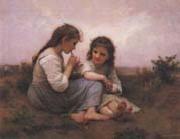 |
Adolphe Bouguereau
|
|
French
1825-1905
French painter. From 1838 to 1841 he took drawing lessons from Louis Sage, a pupil of Ingres, while attending the coll?ge at Pons. In 1841 the family moved to Bordeaux where in 1842 his father allowed him to attend the Ecole Municipale de Dessin et de Peinture part-time, under Jean-Paul Alaux. In 1844 he won the first prize for figure painting, which confirmed his desire to become a painter. As there were insufficient family funds to send him straight to Paris he painted portraits of the local gentry from 1845 to 1846 to earn money. In 1846 he enrolled at the Ecole des Beaux-Arts, Paris, in the studio of Fran?ois-Edouard Picot. This was the beginning of the standard academic training of which he became so ardent a defender later in life. Such early works as Equality (1848; priv. col., see 1984-5 exh. cat., p. 141) reveal the technical proficiency he had attained even while still training. In 1850 he was awarded one of the two Premier Grand Prix de Rome for Zenobia Discovered by Shepherds on the Bank of the River Araxes (1850; Paris, Ecole N. Sup. B.-A.). In December 1850 he left for Rome where he remained at the Villa Medici until 1854, working under Victor Schnetz and Jean Alaux (1786-1864). During this period he made an extensive study of Giotto's work at Assisi and Padua and was also impressed by the works of other Renaissance masters and by Classical art. On his return to France he exhibited the Triumph of the Martyr (1853; Lun?ville, Mus. Lun?ville; see fig. 1) at the Salon of 1854. It depicted St Cecilia's body being carried to the catacombs, and its high finish, restrained colour and classical poses were to be constant features of his painting thereafter. All his works were executed in several stages involving an initial oil sketch followed by numerous pencil drawings taken from life. |
 |
Abraham jansz.begeyn
|
|
Dutch painter and draughtsman , 1637-1697
was a Dutch painter of landscapes and cattle in the manner of Nicolaes Pietersz Berchem. Begeyn's earliest known work is from 1653. In 1655 he joined the painter's guild of Leiden, where he staid until at least 1667. He was then active in Amsterdam and The Hague, before he took his residence in Berlin in 1688. There his works were greatly prized, and, according to Houbraken, he was principal painter to Frederick III, the elector of Brandenburg, afterwards king of Prussia. In many collections in the Netherlands, the pictures of Begeyn are placed amongst those of the most admired masters. His pencilling is light and free, and his colouring very agreeable. Many of his works are landscapes, with views of rivers, ruins, and pieces of architecture, |
 |
Abraham Bloemaert
|
|
(1566, Gorinchem - 27 January 1651, Utrecht), was a Dutch painter and printmaker in etching and engraving. He was one of the "Haarlem Mannerists" from about 1585, but in the new century altered his style to fit new Baroque trends.
Bloemaert was the son of an architect, who moved his family to Utrecht in 1575, where Abraham was first a pupil of Gerrit Splinter (pupil of Frans Floris) and of Joos de Beer. He then spent three years in Paris, studying under several masters, and on his return to his native country received further training from Hieronymus Francken. In 1591 he went to Amsterdam, and four years later settled finally at Utrecht, where he became dean of the Guild of St. Luke.
He excelled more as a colourist than as a draughtsman, was extremely productive, and painted and etched historical and allegorical pictures, landscapes, still-life, animal pictures and flower pieces. In the first decade of the seventeenth-century, Bloemaert began formulating his landscape paintings to include pictoresque ruined cottagges and other pastoral elements. In these works, the religious or mythological figures play a subordinate role. Country life was to remain Bloemaert's favourite subject, which he depicted with increasing naturalism. He drew motifs such as peasant cottages, dovecotes and trees from life and then on his return to the studio, worked them up into complex imaginary scenes.
Among his pupils are his four sons, Hendrick, Frederick, Cornelis, and Adriaan (all of whom achieved considerable reputation as painters or engravers), the two Honthorsts, Ferdinand Bol and Jacob Gerritsz Cuyp.
|
 |
Louis Leopold Boilly
|
|
b.July 5, 1761, La Bass??e, France
d. Jan. 4, 1845, Paris
French
Louis Leopold Boilly Location |
|

